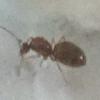Background:
- Caught 8 queens on 7/10/17 @ my local park (Cold Spring Park Woonsocket RI) placed each in a their own test tube set up.
-@ about 45 days in I decided I would try to combine them into pairs with the ultimate goal of making 2 polygynous colonies of around 4 queens. (I have since discovered this is apparently not advised). I did this by joining the tubes together. Two pairs happily moved in together, sharing a single tube. One pair seemed not especially interested in having a roommate and lived separately in their own sides of the joined setup. The final pair lived separately, but shortly after one was found dead and moldy. Foul play is suspected but not confirmed. Needless to say this queen will likely have single accommodations.
- 6/23/17 Nanitics observed, having be unnoticed or overlooked on 6/22 as they are extremely small and almost transparent initially. I had previously purchased 3 AntsCanada test tube portals to serve as initial outworlds. Two setups were connected for a total of 3 queens per test portal excluding her "royal highness" who has her own outword.
- 6/24/17 a testube of food was attatched to the portals. The food was a mixture of 3 tsp raw honey, one pkt of gelatin, 12 oz water, and some red food coloring to determin if they are feeding of this mixture. 5 ml was placed in ea. Feeding testube an allowed to cool. This mixture proved to be too funny and a cotton ball was added to cap and wick the mixture. Less water is recommended.
- 6/25/17 ants do not appear to be feeding on mixture as their gasters show no sign of the red food coloring. One tube was in fact blocked with loose stands of cotton. This suggests a possible rejection of the food (subtle right!), or possibly they are not, as a colony ready for food. The latter is less likely as other New England anters have reported in their journals that their ants have been observed feeding as newly eclosed nanitics. I must consider other food sources. Referring to the preferred food post in "General Anting" forum I notice Bananas and crickets are listed. Will purchase some tonight.
Thought to date: This seems to be a species extremely forgiving of mistakes. They were disturbed often (2-3x per wk). My test tube setups were likely poorly done. The room in which they were kept, at times dropped to ~ 40°F overnight to no ill effect. It seems short of squishing them there is not much that can be done wrong. The only drawback to this species, as a beginner, is the time it takes to get nanitics. From capture to observed nanitics was 74 days and this was very consistent with reports from other New England anters keeping this species, with 74 days (Cindy) and 75 days (NathanT) recorded in their journals.
Hoping raising this colony is equally forgiving.
Edited by RhodyAnts, June 26 2017 - 1:07 PM.
















